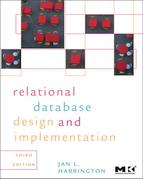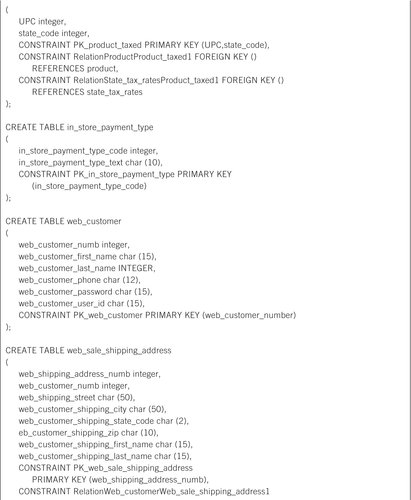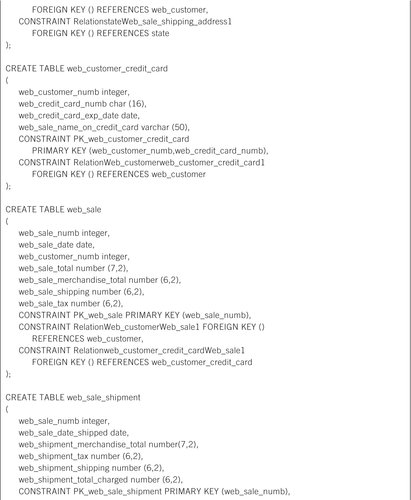Chapter 13. Database Design Case Study 3
SmartMart
Many retail chains today maintain both a Web and a brick-and-mortar presence in the marketplace. Doing so presents a special challenge for inventory control because the inventory is shared between physical stores and Web sales. The need to allow multiple shipping addresses and multiple payment methods within a single order also adds complexity to Web selling. Online shopping systems also commonly allow users to store information about multiple credits.
To familiarize you with what is necessary to maintain the data for such a business, we’ll be looking at a database for SmartMart, a long-established retailer with 325 stores across North America that has expanded into Web sales. SmartMart began as a local grocery store, but over the years it expanded to also sell clothes, sundries, home furnishings, hardware, and electronics. Some stores still have grocery departments; others carry just “dry” goods. In addition to the retail stores, SmartMart maintains four regional warehouses that supply the stores as well as ship products that are ordered over the Web.
The Merchandising Environment
SmartMart has three major areas for which it wants to an integrated database: in-store sales, Web sales, and some limited Human Resources needs. The sales data must be compatible with accounting systems to simplify data transfer. In addition, both the in-store sales and Web sales applications must use the same data about products.
Product Requirements
The products that SmartMart sells are stocked throughout the company's stores, although every store does not carry every product. The database must therefore include data about the following:
▪ Products
▪ Stores
▪ Departments within stores
▪ Products stocked within a specific department
▪ Current sales promotions for a specific product
The store and department data must be integrated with the database's Human Resources data.
In-Store Sales Requirements
The data describing in-store sales serve two purposes: accounting and inventory control. Each sale (whether paid with cash or credit) must decrement inventory and provide an audit trail for accounting. Retaining data about in-store sales is also essential to SmartMart's customer service reputation. The company offers a 14-day return period, during which a customer can return any product with which he or she is not satisfied. Store receipts therefore need to identify entire sales transactions, in particular which products were purchased during a specific transaction.
Because the company operates in several different states, there is a wide variety of sales tax requirements. Both which products are taxed and the sales tax rate vary among states. The database must therefore include sales tax where necessary as a part of an in-store transaction.
The database must distinguish between cash and credit transactions. The database will not store customer data about cash transactions, but it must retain credit card numbers, expiration dates, and customer names on credit sales.
Web Sales Requirements
Web sales add another layer of complexity to the SmartMart data environment. The Web application must certainly have access to the same product data as the in-store sales, but it must also integrate with a shopping cart application.
To provide the most flexibility, SmartMart wants to allow customers to store multiple shipping addresses, ship to multiple addresses on the same order, and store multiple credit card data from which a customer can choose when checking out. In addition, customers are to be given a choice as to whether to pick up their order or have it shipped. The Web application must therefore have access to data about which stores are in a customer's area and what products are available at each store, the same inventory information used by in-store sales.
Finally, the Web application must account for back orders and partial shipments. This means that a shipment is not the same as a Web order, whereas an in-store sale delivers its items at one time. (Should an in-store customer want to purchase an item that is not in stock, the item will be handled as if it were a Web sale.)
Personnel Requirements
Although a complete personnel database is beyond the scope of this case, SmartMart's management does want to be able to integrate some basic HR functions into the database, especially the scheduling of “sales associates” to specific departments in specific stores. The intent is to eventually be able use an expert system to analyze sales and promotion data to determine staffing levels and to move employees among the stores in a region as needed.
Putting Together an ERD
As you might expect, the SmartMart ERD is fairly large. It has therefore been broken into three parts to make it easier to examine and understand.
Stores, Products, and Employees
As you can see in Figure 13-1 (the first third of the ERD), the SmartMart database begins with four “foundation” entities (entities that are only at the “one” end of 1:M relationships): employee, store, warehouse, and product.
The store and warehouse entities, at least at this time, have exactly the same attributes. It certainly would be possible to use a single entity representing any place products were kept. This would remove some of the complexity that arises when locating a product. However, there is no way to be certain that the data stored about a store and a warehouse will remain the same over the life of the database. Separating them into two entities after the database has been in use for some time would be very difficult and time consuming. Therefore, the choice was made to handle them as two distinct entities from the beginning.
Reference Entities
There are also several entities that are included for referential integrity purposes (state, keyword_list, pay_type, promotion_type). These entities become necessary because the design attempts to standardize text descriptions by developing collections of acceptable text descriptions and then using a numbering scheme to link the descriptions to places where they are used. There are two major benefits to doing this.
First, when the text descriptions, such as a type of pay (e.g., hourly versus salaried), are standardized, searches will be more accurate. Assume, for example, that the pay types haven't been standardized. An employee who is paid hourly might have a pay type of “hourly,” “HOURLY,” “hrly,” and so on. A search that retrieves all rows with a pay type of “hourly” will miss any rows with “HOURLY” or “hrly,” however.
Second, using integers to represent values from the standardized list of text descriptions saves space in the database. Given the relative low price of disk storage, this usually isn't a major consideration.
The drawback, of course, is that when you need to search on or display the text description, the relation containing the standardized list and the relation using the integers representing the terms must be joined. Joins are relatively slow activities, but in this case, the reference relation containing the master list of text descriptions will be relatively small; the join uses integer columns, which are quick to match. Therefore, unless for some reason the reference relation becomes extremely large, the overhead introduced by the join is minimal.
Circular Relationships
If you look closely at the employee entity in Figure 13-1, you’ll see a relationship that seems to relate the entity to itself. In fact, this is exactly what that circular relationship does. It represents the idea that a person who supervises other employees is also an employee: The supervisor_id attribute is drawn from the same domain as employee_id. Each supervisor is related to many employees, and each employee has only one supervisor.
It is always tempting to create a separate supervisor entity. Given that a supervisor must also be an employee, however, the supervisor entity would contain data duplicated from the employee entity. This means that we introduce unnecessary duplicated data into the database and run a major risk of data inconsistencies.
Note: To retrieve a list of supervisors and the individuals they supervise, someone using SQL would join a copy of the employee table to itself, matching the supervisor_id column in one table to the employee_id column in the other. The resulting table would contain data for two employees in each row (the employee and the employee's supervisor) that could be manipulated—in particular, sorted—for output as needed.
Mutually Exclusive Relationships
There is one symbol on the ERD in Figure 13-1 that has not been used before in this book: the small circle that sits in the middle of the relationships between a stocked product, a department (in a store), and a warehouse. This type of structure indicates a mutually exclusive relationship. A given product can be stocked in a store or in a warehouse but not both. (This holds true for this particular data environment because a product stocked represents physical items to be sold.)
The structure of the product_stocked entity reflects its participation in this type of relationship. In particular, it contains a Boolean column (in_store) that holds a value of true if the product is stocked in a store; a value of false indicates that the product is stocked in a warehouse. The value of the in_store attribute will then tell a user whether to use the warehouse_numb column or the concatenation of the store_numb column with the dept_numb attribute to find the actual location of an item.
One-to-One Relationships
Earlier in this book you read that true one-to-one relationships are relatively rare. There are, however, three of them visible in Figure 13-1. All involve employees that manage something: a store, a department within a store, or a warehouse. A corporate unit may have one manager at a time, or it may have no manager; an employee may be the manager of one corporate unit or the manager of none. It is the rules of this particular database environment that make the one-to-one relationships valid.
In-Store Sales
The second part of the ERD (Figure 13-2) deals with in-store sales. The data that are common to cash and credit sales are stored in the in_store_sale entity. These data are all that are needed for a cash sale. Credit sales, however, require data about the credit card used (the credit_sale_details entity). Notice that there is therefore a one-to-one relationship between in_store_sale and credit_sale_details. The two-entity design is not required for a good database design, but it has been chosen for performance reasons with the assumption that there will be many more cash transactions than credit transactions. It therefore is a way of providing vertical partitioning to a single data set that is somewhat “unbalanced.” In other words, a small proportion of the occurrences of the entity will have credit details, while others will not.
After SmartMart's database has been in production for some time, the database administrator can look at the actual relative proportion of credit and cash sales. If a large proportion of the sales are credit, then it may make sense to combine in_store_sale and credit_sale_details into a single entity and simply leave the credit details columns as null for cash sales. Although some space will be wasted, this combined design avoids the need to perform a lengthy join when retrieving data about a credit sale.
Web Sales
The third portion of the ERD (Figure 13-3) deals with Web sales. Each Web sale uses only one credit card, but a Web customer may keep more than one credit card number within SmartMart's database. A customer may also keep more than one shipping address; multiple shipping addresses can be used within the same order. (Multiple credit cards for a single order are not supported.)
At first glance, it might appear that the three relationships linking web_customer, web_sale, and web_customer_credit_card form a circular relationship. However, the meaning of the relationships is such that the circle does not exist:
▪ The direct relationship between web_customer and web_customer_credit_card represents the cards that a Web customer has allowed to be stored in the SmartMart database. The credit card data are retrieved when the customer is completing a purchase. He or she chooses one for the current order.
▪ The relationship between web_customer and web_sale connects a purchase to a customer.
▪ The relationship between web_customer_credit_card and web_sale represents the credit card used for a specific order.
It can be difficult to discern such subtle differences in meaning from a simple ERD. There are two solutions: define the meaning of the relationships in the data dictionary or add relationship names to the ERD.
The web_sale_shipping_address entity is used to display addresses from which a user can choose. However, because items within the same shipment can be sent to different addresses, there is a many-to-many relationship between web_sale and web_sale_shipping_address. The web_sale_item resolves that many-to-many relationship into two one-to-many relationships.
The relationship among web_sale, web_sale_item, and web_sale_shipment is ultimately circular, although at the time the order is placed, there are no instances of the web_sale_shipment entity. The circle is closed when items actually ship.
Creating the Tables
The ERDs you have just seen produce the following tables, listed in alphabetical order:
credit_sale_details (in_store_transaction_numb, in_store_sale_credit_card_numb, in_store_exp_date, in_store_sale_name_on_credit_card)
department (dept_numb, store_numb, dept_manager_id)
employee (employee_id, employee_first_name, employee_last_name, employee_street, employee_city, employee_state_code, employee_zip, employee_phone, employee_ssn, employee_birth_date, dept_id, store_numb, supervisor_id, pay_type_code, pay_rate)
in_store_payment_type (in_store_payment_type_code, in_store_payment_type_text)
in_store_sale (in_store_transaction_numb, in_store_transaction_date, in_store_sale_product_total, in_store_sales_tax,in_store_total, in_store_payment_type_code)
in_store_sale_item (in_store_sale_transaction_numb, in_store_SKU, in_store_quantity, in_store_price)
keyword_list (keyword_code, keyword_text)
pay_type (pay_type_code, pay_type_description)
product (UPC, product_name, product_unit, shipping_weight, product_image, web_orderable)
product_keyword (UPC, keyword_code)
product_stocked (SKU, UPC, in_store, store_numb, dept_numb, warehouse_numb, size, color, number_on_hand, retail_price)
product_taxed (UPC, state_code)
promotion_type (promotion_type_code, promotion_type_name)
sales_promotion (UPC, promotion_start_date, promotion_end_date, promotion_type_code, promotion_details)
state (state_code, state_name)
state_tax_rates (state_code, sales_tax_rate)
store (store_numb, store_street, store_city, store_state_code, store_zip, store_main_phone, store_manager_id)
web_customer (web_customer_numb, web_customer_first_name, web_customer_last_name, web_customer_phone, web_customer_password, web_customer_user_id)
web_customer_credit_card (web_customer_numb, web_credit_card_numb, web_credit_card_exp_date, web_sale_name_on_credit_card)
web_sale (web_sale_numb, web_sale_date, web_customer_numb, web_sale_total, web_sale_merchandise_total, web_sale_shipping,web_sale_tax)
web_sale_item (web_sale_numb, web_sale_SKU, web_sale_quantity, web_sale_shipped, web_sale_price, web_shipping_address_numb)
web_sale_shipment (web_sale_numb, web_sale_date_shipped, web_shipment_merchandise_total, web_shipment_tax, web_shipment_shipping, web_shipment_total_charged)
web_sale_shipping_address (web_shipping_address_numb, web_customer_numb, web_shipping_street, web_shipping_city, web_shipping_state_code, web_customer_zip, web_customer_shipping_first_name, web_customer_shipping_last_name)
web_security_question (web_security_question_numb, web_security_question_text)
web_security_question_answer (web_security_question_numb, web_customer_numb, web_security_answer_text)
work_schedule (employee_id, work_date, work_start_time, work_hours_scheduled)
Because of the circulation relationship between a supervisor, who must be an employee, and an employee being supervised, the employee table contains a foreign key that references the primary key of its own table: supervisor_id is a foreign key referencing employee_id. There is nothing wrong with this type of design. The definition of a foreign key states only that the foreign key is the same as the primary key of some table; it does not rule out the foreign key referencing the primary key of its own table.
Generating the SQL
The case tool that generated the SQL misses some very important foreign keys—the relationships between employees and various other entities—because the two columns don't have the same name (see Figure 13-4). Therefore, the database designer must add the constraints manually to the foreign key tables’ CREATE TABLE statements:
employee table: FOREIGN KEY (supervisor_id) REFERENCES employee (employee_id)
warehouse table: FOREIGN KEY (warehouse_manager_id) REFERENCES employee (employee_id)
department table: FOREIGN KEY (department_manager_id) REFERENCES employee (employee_id)
store table: FOREIGN KEY (store_manager_id) REFERENCES employee (employee_id)
The manual foreign key insertions could have been avoided had the manager IDs in the warehouse, department, and store tables been given the name employee_id. However, it is more important in the long run to have the column names reflect the meaning of the columns.
There is also one foreign key missing of the two needed to handle the mutually exclusive relationship between a product stocked and either a department (in a store) or a warehouse. The foreign key from product_stocked to the department is present but not the reference to the warehouse table. The database designer must therefore add the following to the product_stocked table:
FOREIGN KEY (warehouse_numb) REFERENCES warehouse (warehouse_numb)
You may be wondering whether there could be a problem with including the two constraints if only one can be valid for any single row in product_stocked. There won't be, because, as we saw before, referential integrity constraints are used only when the foreign key is not null. Therefore, a product stocked in a warehouse will have a value in its warehouse_numb column but null in the store_numb and dept_numb columns. The reverse is also true: A product stocked in a store will have values in its store_numb and dept_numb columns but null in the warehouse_numb column.
The foreign key relationships to the state reference relation must also be added manually because the foreign key columns do not have the same name as the primary key column in the state table. Whether to use the same name throughout the database (state_name) is a design decision. If all of the tables that contain a state use the same name, foreign keys will be added automatically by the CASE tool. However, depending on the way the states are used, it may be difficult to distinguish among them if the column names are all the same.
..................Content has been hidden....................
You can't read the all page of ebook, please click here login for view all page.











